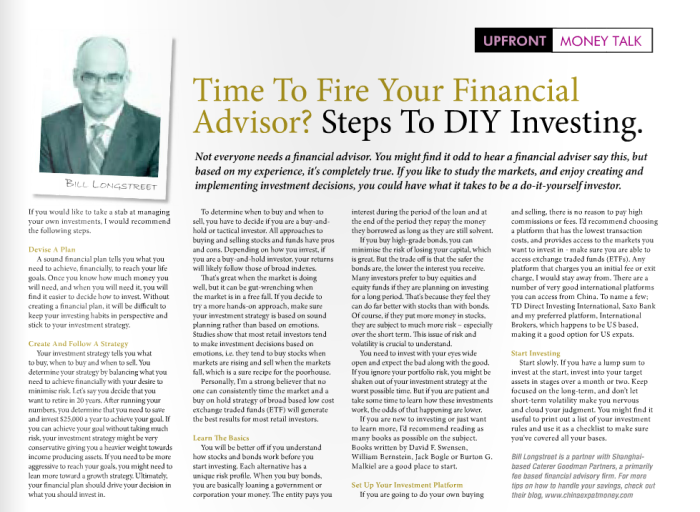Time To Fire Your Financial Advisor? Steps To DIY Investing
Posted on June 18, 2015This article was first published on Talk Magazine Shanghai Jun 2015 edition.
 Not everyone needs a financial advisor. You might find it odd to hear a financial adviser say this, but based on my experience, it’s completely true. If you like to study the markets, and enjoy creating and implementing investment decisions, you could have what it takes to be a do-it-yourself investor.
Not everyone needs a financial advisor. You might find it odd to hear a financial adviser say this, but based on my experience, it’s completely true. If you like to study the markets, and enjoy creating and implementing investment decisions, you could have what it takes to be a do-it-yourself investor.If you would like to take a stab at managing your own investments, I would recommend the following steps.
Devise A Plan
A sound financial plan tells you what you need to achieve, financially, to reach your life goals. Once you know how much money you will need, and when you will need it, you will find it easier to decide how to invest. Without creating a financial plan, it will be difficult to keep your investing habits in perspective and stick to your investment strategy.
Create And Follow A Strategy
Your investment strategy tells you what to buy, when to buy and when to sell. You determine your strategy by balancing what you need to achieve financially with your desire to minimise risk. Let’s say you decide that you want to retire in 20 years. After running your numbers, you determine that you need to save and invest $25,000 a year to achieve your goal. If you can achieve your goal without taking much risk, your investment strategy might be very conservative giving you a heavier weight towards income producing assets.
If you need to be more aggressive to reach your goals, you might need to lean more toward a growth strategy. Ultimately, your financial plan should drive your decision in what you should invest in. To determine when to buy and when to sell, you have to decide if you are a buy-andhold or tactical investor. All approaches to buying and selling stocks and funds have pros and cons. Depending on how you invest, if you are a buy-and-hold investor, your returns will likely follow those of broad indexes.
That’s great when the market is doing well, but it can be gut-wrenching when the market is in a free fall. If you decide to try a more hands-on approach, make sure your investment strategy is based on sound planning rather than based on emotions. Studies show that most retail investors tend to make investment decisions based on emotions, i.e. they tend to buy stocks when markets are rising and sell when the markets fall, which is a sure recipe for the poorhouse. Personally, I’m a strong believer that no one can consistently time the market and a buy on hold strategy of broad based low cost exchange traded funds (ETF) will generate the best results for most retail investors.
Learn The Basics
You will be better off if you understand how stocks and bonds work before you start investing. Each alternative has a unique risk profile. When you buy bonds, you are basically loaning a government or corporation your money. The entity pays you interest during the period of the loan and at the end of the period they repay the money they borrowed as long as they are still solvent.
If you buy high-grade bonds, you can minimise the risk of losing your capital, which is great. But the trade off is that the safer the bonds are, the lower the interest you receive. Many investors prefer to buy equities and equity funds if they are planning on investing for a long period. That’s because they feel they can do far better with stocks than with bonds. Of course, if they put more money in stocks, they are subject to much more risk – especially over the short term. This issue of risk and volatility is crucial to understand.
You need to invest with your eyes wide open and expect the bad along with the good. If you ignore your portfolio risk, you might be shaken out of your investment strategy at the worst possible time. But if you are patient and take some time to learn how these investments work, the odds of that happening are lower.
If you are new to investing or just want to learn more, I’d recommend reading as many books as possible on the subject. Books written by David F. Swensen, William Bernstein, Jack Bogle or Burton G. Malkiel are a good place to start.
Set Up Your Investment Platform
If you are going to do your own buying and selling, there is no reason to pay high commissions or fees. I’d recommend choosing a platform that has the lowest transaction costs, and provides access to the markets you want to invest in – make sure you are able to access exchange traded funds (ETFs). Any platform that charges you an initial fee or exit charge, I would stay away from. There are a number of very good international platforms you can access from China. To name a few; TD Direct Investing International, Saxo Bank and my preferred platform, International Brokers, which happens to be US based, making it a good option for US expats.
Start Investing
Start slowly. If you have a lump sum to invest at the start, invest into your target assets in stages over a month or two. Keep focused on the long-term, and don’t let short-term volatility make you nervous and cloud your judgment. You might find it useful to print out a list of your investment rules and use it as a checklist to make sure you’ve covered all your bases.
Bill Longstreet has been a financial advisor since 2003 and prior to this were a institutional business development director, specializing in fixed income and foreign exchange markets. Bill has a Master in Business Administration with a concentration in Finance (1999) from the Olin School of Business at Washington University in St. Louis and am a candidate for the CFP (Certificate Financial Planner) qualification. He also holds a Bachelor of Arts with a Major in Economics from Denison University. In his last position before joint Caterer Goodman oversaw $350 million in client funds across a range of currencies and risks profiles.
Tags: 1 Caterer Goodman Partners, Advice, American, Bill, Bill Longstreet, Caterer Goodman, Caterer Goodman Partners, China Expat Money, Fee only, Fee-based, Financial Advisor, Investment, Shanghai, Shanghai Expat, Tips, US, Wealth Management
Categorised in: American Investors, Caterer Goodman Partners, Caterer-Goodman-Partners, Financial Advice, General, Investments


